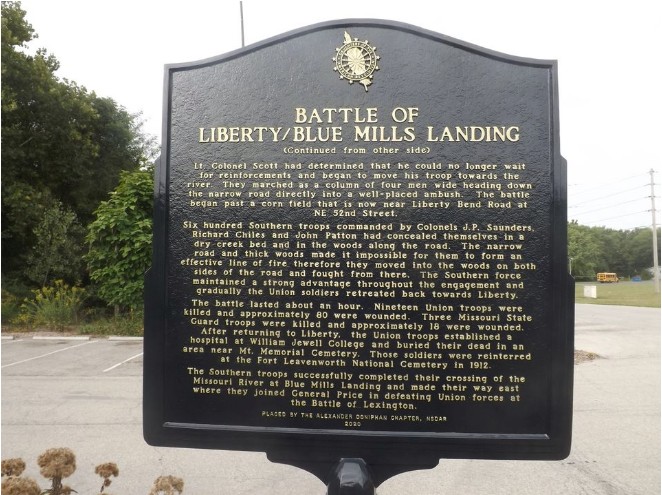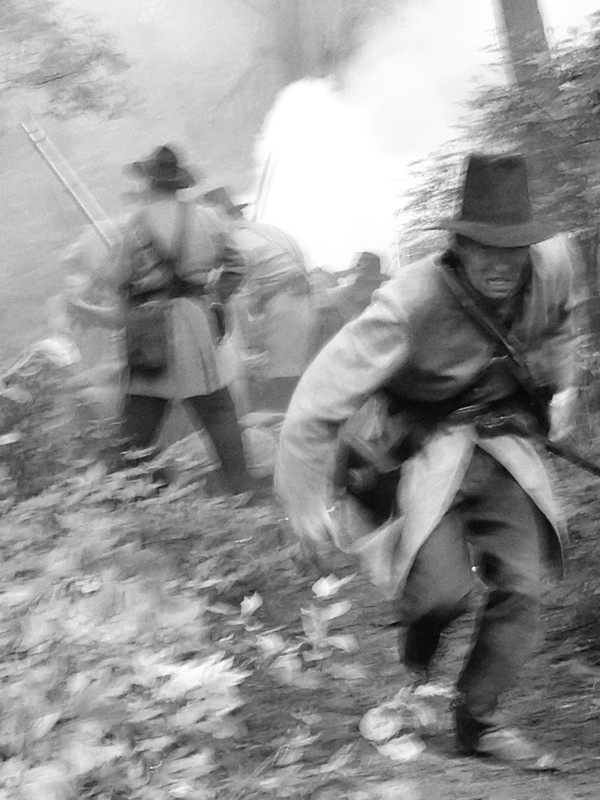Battle of Liberty (Blue Mills Landing) Clay County, Missouri
Introduction
Text-to-speech Audio
Dedicated in 2020, this historical marker commemorates a Civil War battle that occurred near this location on September 17, 1861. A critical engagement within an early series of skirmishes and battles that would shape control of Missouri at the start of the war, the Battle of Liberty saw an outnumbered Union force repulsed by a larger pro-Confederate force under the command of David Rice Atchison. Atchison's victory bolstered the campaign of Confederate General Sterling Price, but with more Union troops entering the state, Price was unable to achieve his goal of securing control of Missouri in the fall of 1861 or the years that followed, including a major campaign in 1864. While Missouri remained a Border State within the Union, residents near Liberty generally sided with the Confederacy.
Images
A New Historic Marker Emplaced in the Immediate Vicinity in Which the Battle of Liberty Transpired.

A dramatization of the Battle of Liberty, reenacted by local historians from Clay County.

Backstory and Context
Text-to-speech Audio
Of the 114 counties comprising the state of Missouri in 1861, Clay County was home to numerous episodes of violence during the war, including shootouts, duels, kidnapping, and other altercations between patrolling Yankees and roving bands of bushwhackers. However, the Battle of Liberty was the only formal combat engagement between Union and Secessionist forces during the Civil War. This particular engagement may seem minor when juxtaposed to major battles in Virginia or turning points like Antietam Gettysburg. However, this battle was significant in the history of Missouri, a Border State that was mostly controlled by U.S. forces but could have shifted the balance of power had this Confederate victory been followed up by similar victories.
The Battle of Liberty occurred on September 17, 1861, when soldiers loyal to the United States attempted to stop Secessionist forces organized as a state-sponsored military organization under General Sterling Price. In the aftermath of the Battle of Wilsons Creek on August 10, 1861, General Price sought to amass his troops, consolidate his resources, and move towards St. Louis in a headlong push to expel federal forces out of Missouri. If successful, Price and other Confederate supporters hoped, more Missouri residents and prospective soldiers would rally to the pro-slavery cause. Along with Kentucky, Delaware, and Maryland, Missouri was one of four states at that time that had not joined the Confederacy. (West Virginia's secession from Virginia and recognition as a new state in 1863 brought the total to five Border States).
At this critical juncture, Price diverted from his presupposed route-of-approach, and moved toward the riverside town of Lexington instead, intent on securing possession of Federal banknotes housed in the general vicinity. As Price ventured northward toward Lexington from Springfield, additional secessionist units operating in the northwestern quarter of the state mobilized near St. Joseph and likewise departed from their initial jumping-off point in an effort to rendezvous with Price at Lexington. In order to attain this objective, those additional pro-Confederate Missouri State Guard units now en route from St. Joseph faced the task of evading interception from pursuing Federal troops as well as crossing the Missouri River at one of the few remaining river landings at Blue Mills in Clay County (within close proximity to the city of Liberty).
After a two-day trek, the Secessionist reinforcements arrived in Clay County and began their traversal of the river. At that moment, Federal infantrymen belonging to the 3rd Iowa Infantry Regiment under Colonel John Scott, converged on the pro-secessionist lookouts at the rear of the convoy as the Missouri men made the crossing by flatboat. Owing largely to the dense foliage and undergrowth that swallowed much of the terrain, secessionist forces let loose a whirlwind of buckshot and musketry into the heaving ranks of the Federal soldiers. These U.S. troops were close-packed at that time, and the result of the musket fire led to shock and disorientation. The battle raged for approximately two and a half hours and concluded with secessionist forces successfully traversing the Missouri River. The tactical Confederate victory saw the battered Iowans pushed from the field. The secessionist troops arrived at Lexington, where Price’s siege of the Yankee entrenchments there led to control of much-needed supplies. The Confederate victory in the Battle of Liberty was significant, and Union casualties were taken to a nearby hospital at William Jewel College, which also became the site of a small cemetery for those who perished in this battle.
Sources
History of Clay and Platte Counties, Missouri. St. Louis, Missouri: National Historical Co., 1885.
McElroy, John. The Struggle for Missouri. Washington, D.C: The National Tribune Co., 1909.
Phisterer, Frederick. Statistical Records of the Armies of the United States. Edison, New Jersey: Castle Books, 2002.
Webb, William Larkin. Battles and Biographies of Missourians, or, The Civil War Period of Our State. Kansas City, Missouri: Hudson-Kimberly Publishing Co., 1900.
Withers, Ethel Massie. Clay County Missouri Centennial Souvenir: 1822 - 1922. Liberty, Missouri: The Liberty Tribune, 1922.
https://mo-passport.org/liberty/
